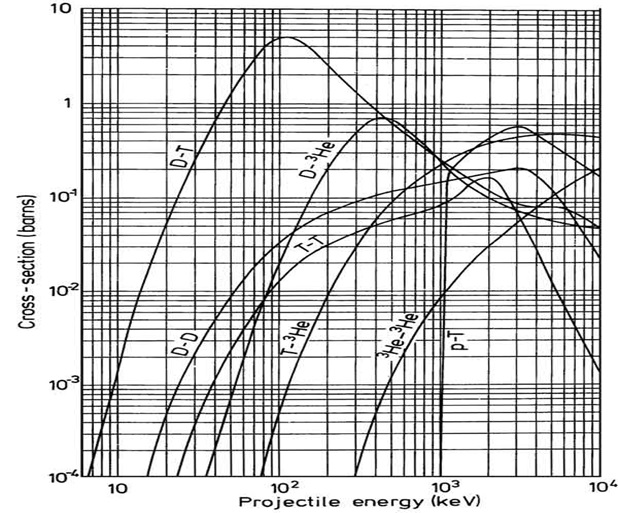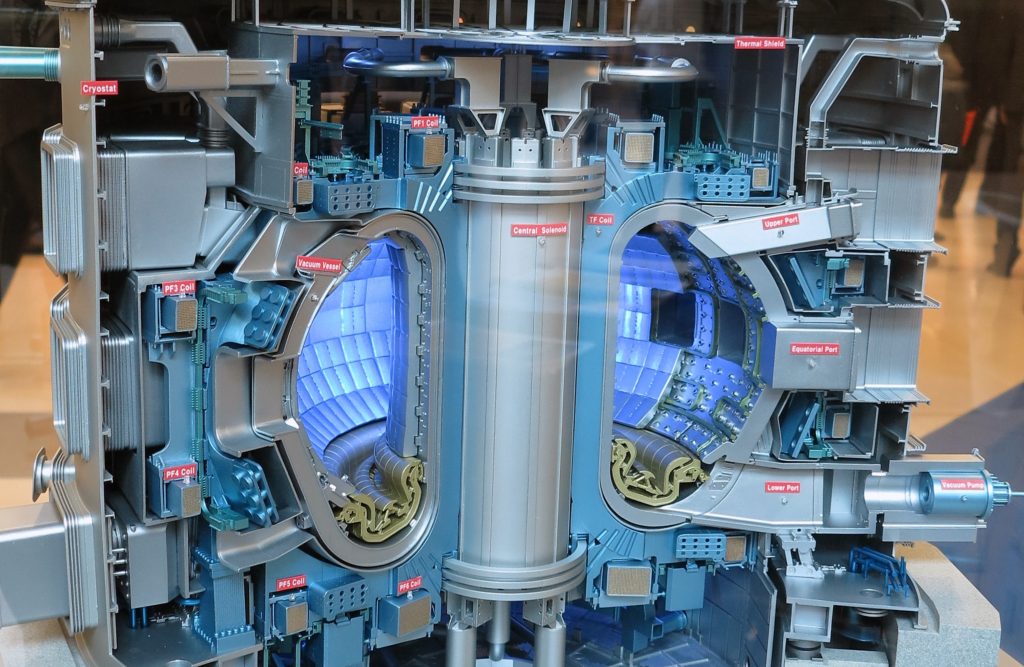With considerable research currently being done in the field of magnetic confinement fusion, sometimes you need to go back to the basics to understand some of the physics behind this. Recent developments in China (EAST), South Korea (KSTAR), and France (ITER) show that more countries are dedicating research dollars in this field, as it becomes more feasible. The current world record for energy gained (Q value) is held by JT-60 (Japan) at 1.25. In a power plant application, excess heat would be collected by a coolant, which in turn would drive a turbine and generate electricity.

The two opposing forces in an atom’s nucleus are the electrical repulsion between positively charged protons, and the strong nuclear force pulling all protons and neutrons in the nucleus together and, if the numbers of protons and neutrons are not too different, overpowers electrical forces. These two forces are most-perfectly balanced in Iron-56, where the binding energy per nucleon (proton or neutron) is the highest.
So what is fusion then?
Nuclear fusion is the physical process of joining together two or more atomic nuclei to form one larger nucleus. This process is exothermal for all fusion reactions which involve nuclei lighter than Iron-56 (this nucleus is in the sweet spot and has the highest nuclear binding energy of any isotope). The electrostatic repulsion of light nuclei is stronger than the force binding them, the strong nuclear force. For larger nuclei like Uranium, there is more energy released from splitting the atoms, through nuclear fission.
When two light nuclei come close enough to overcome their electrostatic repulsion and form a heavier nucleus, they release energy. To overcome this tremendous electrostatic force, the nuclei must somehow gain more energy than their binding energy and come close enough to collide and fuse, rather than bounce off. For some reactions, this binding energy is larger than for others. The energy available from a D-T reaction is 338 TJ/kg, while the energy available from a Uranium 235 fission is 77 TJ/kg on average. This process of nuclear fusion is often described using the reaction cross-section.

Cross-sections of various fusion reactions
The reaction cross section is best understood as the area surrounding one ion nucleus in which another ion nucleus must enter in order for fusion to occur. In the case of fission, it is the area surrounding the Uranium nucleus in which a neutron must enter to cause fission. In the case of fusion, it is better understood as the area surrounding two ion’s centre of mass in which the two ions must enter, in order for these ions to fuse. At such a close distance, the ions overcome their electrostatic repulsive force. To determine the fusion (or fission) reaction rate, the following equation is used:
![]()
Where: R – reaction rate [number/cm2-sec], σ – cross-sectional area [cm2], I – incident ion/neutron beam intensity [number / cm2-sec], NA – target atom/ion density [number / cm2]. The D-T reaction has the highest cross section of all known fusion reactions (figure 2) making it the most sought after.

By comparison, a nuclear fission cross-section, with data for both U-235 and Pu-239.

Based solely on the vertical scale, you can see that fission cross sections are much larger than fusion cross sections, due to the electrostatic force that must be overcome for fusion. In a fusion reactor conditions must exist not only for fusion to occur, but also to sustain the fusion reaction solely on the energy released from fusion. The ability for a fusion reactor to be self-sustaining is often described using the Lawson Criterion. For those that want to nerd out, here are some equations related to how we can reach nuclear fusion. otherwise, you can move on to the fusion energy gain factor to understand a little more about fusion reactors.
Lawson Criterion
The Lawson criterion defines the conditions needed for a fusion reactor to reach ignition: the energy released from fusion reactions is sufficient to maintain the plasma temperature considering all losses and without an external power source. This criterion, in its simplest form, is stated as the volume rate heating multiplied by the energy released should be greater than all losses:
![]()
Where: f – volume rate of heating by fusion, Ech – energy released due to fusion, and Ploss –all losses. As an example, for the D-T reaction, this can be written as the plasma electron density multiplied by the energy confinement time needs to be greater than :
![]()
Where: ne – electron density within the plasma, τE – energy confinement time, defined as the energy content divided by the rate of energy loss. For specific methods of fusion power, other criteria better describe the necessary fusion conditions.
Tripple Product
The triple product of electron density, confinement time and temperature adds temperature into the picture. The energy inequality is often written as:

Where: all past terms have the same meaning, T – temperature, kB – Boltzmann constant, σ – fusion cross section, v – relative ion (particle) velocity, <> – denotes the Maxwellian velocity distribution at the given temperature T. For the D-T reaction, this inequality is found to be:
![]()
These inequalities show the energy required to maintain a fusion reaction. However, to actually produce a net electrical energy in a power plant (either using the Brayton cycle or the Rankin cycle) is considerably larger than the energy required to sustain the reaction.
Fusion Energy Gain Factor (Q)
The fusion energy gain factor is generally used for specific fusion research reactors; it is defined as the rate of energy production to the power required to maintain a fusion reaction (typically the triple product for magnetic confinement fusion). Most current fusion reactors use the D-T reaction, and most of the energy in this reaction comes from fast neutrons. These fast neutrons can escape from the plant, and heat a moderator, typically water, helium, or lithium, and create power through a thermal power cycle. This electrical power generated is defined as ![]() where
where ![]() is the proportion of energy from fusion (
is the proportion of energy from fusion (![]() ) that is stored in the fusion products (
) that is stored in the fusion products (![]() is stored as fast neutrons), and
is stored as fast neutrons), and ![]() is the total efficiency of the power plant. Some power is recirculated (
is the total efficiency of the power plant. Some power is recirculated ( ![]() ) mostly into both heating the plasma but also providing background power for the power plant systems. The reheat power is defined as
) mostly into both heating the plasma but also providing background power for the power plant systems. The reheat power is defined as ![]() . The other source of fusion heating is the fusion by-products, defined as
. The other source of fusion heating is the fusion by-products, defined as ![]() . Therefore, the fusion energy gain factor can be written as:
. Therefore, the fusion energy gain factor can be written as:
![]()
Where Pheat can be written as
![]()
For a Q of 1, the actual ion heating that comes from the reaction by-products is about 20%. For a Q of 5, more heating comes from the by-products than from recirculation. A commercial power plant would require a Q of about 20 in to produce enough electrical power at current prices to make the power plant economically feasible. There is a considerable amount of fusion power plant concepts currently under investigation, each currently achieving a different Q value.
Energy loss in fusion reactors
Apart from the typical culprits of energy loss (fast neutrons escaping, the mixing of plasma wall material with the rest of the plasma), fusion reactors suffer from some unique forms of energy loss. Bremsstrahlung radiation is caused when electrons collide with ions, accelerating the electron and stealing energy from the ion. This radiation is visible for all plasma.
It should be noted that fusion power plants using a plasma require a large vacuum (on the scale of μPa). Therefore, the whole reactor inside needs to be airtight.
Did you like this article? Check out another one of our articles on the top different types of fusion reactors!
